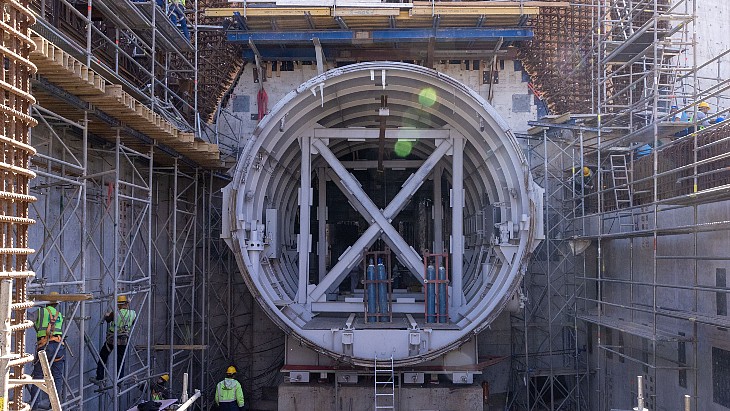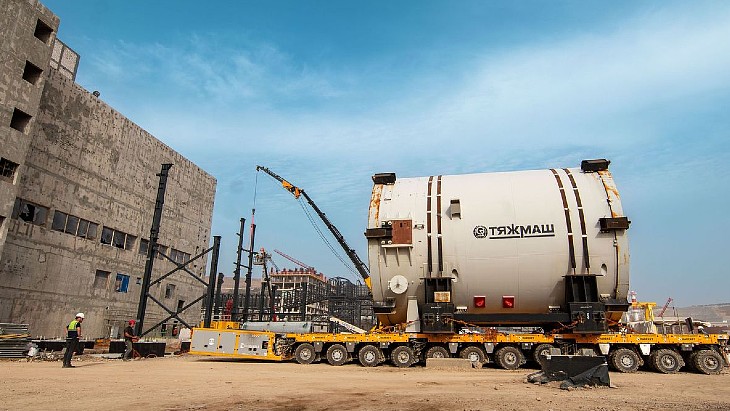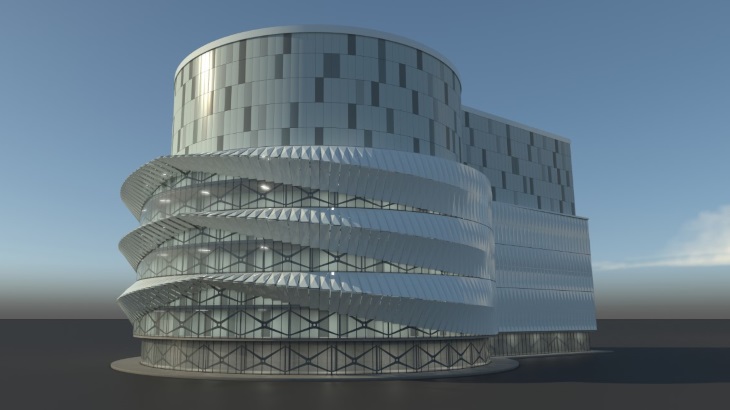Kazatomprom issues quarterly update
03 May 2024
The Kazakh national atomic company's first quarter uranium production saw a slight year-on-year increase but its guidance metrics remain unchanged. Kazatomprom's first quarter trading announcement also included an update on plans for a new sulphuric acid plant.
.jpg?ext=.jpg) (Image: Kazatomprom)
(Image: Kazatomprom)Production for the quarter was 5077 tU (100% basis), up from 4744 tU for the same period in 2023, a year-on-year increase of 7%. The company reiterated that its production guidance for 2024 of 21,000-22,500 tU (100% basis) remains unchanged but noted that "sanctions pressure due to the Russian-Ukrainian conflict and limited access to some key materials are not known" and "as a result, annual production volumes may differ from internal expectations".
The company said it does not anticipate any effect on Kazatomprom from an act prohibiting the import of Russian enriched uranium products into the USA which was passed by the US Senate this week and is now to be signed into law, since its primary business is the production of natural uranium. "Whether shipped by Kazatomprom or its JV partners, Kazakh-origin uranium retains its origin until its arrival at a conversion facility," the company noted.
It reiterated that the recent severe floods in western and northern regions of Kazakhstan had not affected its uranium mining, processing and transportation activities to date and all Kazatomprom enterprises continue to operate without any disruptions. It said it "continues to monitor the situation around the floods in Kazakhstan, and contributes to restoring vital infrastructure and supporting affected communities".
In 2023, Kazatomprom set up a partnership enterprise, Taiqonyr Qyshqyl Zauyty LLP (TQZ) to implement a project to build a new sulphuric acid plant, but said it now expects the completion of the construction and the start of production at the TQZ plant to be postponed from 2026 to 2027 due to "restructuring procedures and delays in the timing of approval of project design documentation". TQZ is partnering with Italian firm Ballestra which will be responsible for the project's design, equipment procurement and technical support.
Akkuyu nuclear plant's first airlock gateway installed
03 May 2024
The 7-metre diameter and 14-metres long cylindrical chamber has an airlock system allowing the moving of material or equipment into and out of the heart of the first unit at Turkey's new Akkuyu Nuclear Power Plant.
 (Image: Rosatom)
(Image: Rosatom)
The 260-tonne structure was installed using a caterpillar crane. It will allow the delivery of equipment for the operation and maintenance of the reactor compartment, such as the upper reactor unit, reactor coolant pump, primary circuit pipelines and steam generators.
Once the unit is in operation, used and fresh fuel and other equipment can pass through it, with the doors at either end able to maintain an airlock system to ensure the reactor compartment remains sealed.

(Image: Rosatom)
Sergei Butckikh, first deputy CEO of Akkuyu NPP, said the installation meant they were "one step closer to the completion" of the first unit and it was "a result of well-coordinated and labour-intensive work of Russian and Turkish specialists" working in the Akkuyu project team.
Akkuyu, in the southern Mersin province, is Turkey's first nuclear power plant. Rosatom is building four VVER-1200 reactors, under a so-called BOO (build-own-operate) model. According to the terms of the Intergovernmental Agreement between the Russian Federation and the Republic of Turkey, the commissioning of the first power unit of the nuclear power plant must take place within seven years from receipt of all permits for the construction of the unit.
The licence for the construction of the first unit was issued in 2018, with construction work beginning that year. Nuclear fuel was delivered to the site in April 2023. Turkey's Nuclear Regulatory Agency issued permission for the unit to be commissioned in December, and in February it was announced that the reactor compartment had been prepared for controlled assembly of the reactor - and the generator stator had also been installed in its pre-design position.
The aim is for the unit to begin supplying Turkey's energy system in 2025. When the 4800 MWe plant is completed it is expected to meet about 10% of Turkey's electricity needs, with the aim that all four units will be operational by the end of 2028.
Holtec sets up maintenance and modification subsidiary
02 May 2024
US company Holtec International has established a wholly-owned subsidiary aiming to "energise the presently placid business sector of modification and maintenance", with the initial project being the restart of the Palisades plant.
.jpg?ext=.jpg) Palisades (Holtec)
Palisades (Holtec)
Holtec Maintenance & Modification International (HMI) is based in Chattanooga, Tennessee, and is being headed by Christopher Bakken. In its statement announcing the move, Holtec International said the new company's mission was "to meet the time-critical maintenance and modification needs of the world’s operating nuclear power plants with assured performance certainty".
It added: "To provide maximum value to its clients, HMI is poised to introduce cutting edge technologies such as AI-aided preventive maintenance and robot-led crew radiation dose reduction methods at its clients’ plants ... we believe the HMI management model will bring about a vastly improved control of operating costs of nuclear plants and ensure heightened plant reliability, which will support the expected renaissance in nuclear generation around the world."
HMI will operate under its parent company's programmes on nuclear quality assurance, environmental protection, personnel safety assurance, corporate governance and supply management "but will be otherwise autonomous". It will work with Holtec’s Nuclear Power Division "to provide replacement components and systems - reverse engineered as necessary to replace obsolescent items - to meet target outage schedules".
As well as its initial work on the project to restart the 840 MWe Palisades plant, Holtec says that "discussions with other clients in the USA and overseas are under way".
Rick Springman, Holtec’s President of Global Clean Energy Opportunities, said: "With the launch of HMI, we can now provide an integrated capability to meet the operating needs of the scores of SMR-300 plants that we hope to be building in the US and around the world."
Holtec agreed to purchase Palisades from then-owner and operator Entergy in 2018, ahead of the scheduled closure, for decommissioning. The acquisition was completed in June 2022, within weeks of the reactor's closure, and at that time Holtec planned to complete the dismantling, decontamination, and remediation of the plant by 2041. But the company then announced plans to apply for federal funding to enable it to reopen the plant, with Michigan Governor Gretchen Whitmer amongst those pledging support for the move. The State of Michigan's Fiscal Year 2024 budget, signed by Whitmer in mid-2023, provides USD150 million in funding towards the plant's restart. In March, the US Department of Energy Loan Programs Office conditionally committed up to USD1.52 billion for a loan guarantee to Holtec Palisades for its project to bring the Palisades plant back online. The aim is for Palisades to be back operating by the end of 2025.
Holtec has also said it intends to locate its first two small modular reactor (SMR) units at Palisades. It also has hopes for fleets of its 160 MWe SMRs elsewhere - in Europe in countries including Ukraine, the Czech Republic and the UK.
STEP components to undergo testing in Czech research reactor
02 May 2024
High temperature superconducting (HTS) tapes for use in the UK's prototype fusion power plant will be tested in a Czech research reactor following the signing of an agreement between the UK Atomic Energy Authority (UKAEA) and Research Centre Řež.
.jpg?ext=.jpg) The LVR-15 research reactor (Image: CVŘ)
The LVR-15 research reactor (Image: CVŘ)
The UKAEA carries out fusion energy research on behalf of the UK government, overseeing the country's fusion programme, including the MAST Upgrade (Mega Amp Spherical Tokamak) experiment as well as hosting the recently closed Joint European Torus (JET) at Culham, which operated for scientists from around Europe. It is also developing its own fusion power plant design with plans to build a prototype known as STEP (Spherical Tokamak for Energy Production) at West Burton in Nottinghamshire, which is due to begin operating by 2040.
Under a multi-year use of facility agreement, UKAEA and Research Centre Řež (CVŘ) will develop a first-of-a kind test rig - called Hi-CrIS (High neutron fluence Cryogenic Irradiation of Superconductors) - to provide data on the effect of a fusion-relevant neutron spectrum on superconducting properties of HTS tapes. These will be used in the STEP prototype plant to confine the fusion plasma which can reach temperatures ten times hotter than the core of the Sun (about 150 million degrees Celsius).
The rig, expected to be operational in 2026, will produce test results to help inform the design and lifespan of STEP's superconducting magnetic components. These components will operate under cryogenic temperatures, and will be subjected to a high flux of high energy neutrons due to their close proximity to the fusion plasma.
During the experiment, the samples will be irradiated with high energy neutrons using CVŘ's LVR-15 light water tank-type research reactor. They will then remain at -253°C whilst being transported and measured within the test rig setup.
The Hi-CrIS test rig will allow samples of HTS tapes to be cooled to the same cryogenic temperatures expected for STEP's superconducting magnets. Maintaining the sample temperature during irradiation, transportation and measurement is critical in understanding how the HTS tapes degrade within their operating environment.
 How the STEP building may look (Image: UKAEA)
How the STEP building may look (Image: UKAEA)
"We are excited to reach this agreement with CVŘ for building and operating a complex test rig using their LVR-15 research reactor," said Fiona Harden, STEP Hi-CrIS technical lead for UKAEA. "The objectives of Hi-CrIS are critical to fusion power plant design and this importance is recognised by our partner who has worked openly with us to put this agreement in place.
"We were delighted to host CVŘ representatives at UKAEA's Culham Campus, promoting the close collaborative approach of both UKAEA and CVŘ to reach our objective, whilst maximising many secondary benefits that this agreement will generate."
CVŘ Business Development Manager Marek Miklos: "Working in partnership with the STEP team is a fantastic opportunity to support the UK's world-leading programme to develop a prototype fusion energy plant. The Hi-CrIS testing rig will open lots of opportunities for further material studies for fusion applications."
UKAEA noted that in addition to testing superconductor components, Hi-CrIS could also enable alternative materials testing for the potential development of future fusion power plants.
The aim for the first phase of work on STEP is to produce a 'concept design' by the end of this year. The UK government is providing GBP220 million (USD227 million) of funding for this part. The next phase of work will include detailed engineering design, while all relevant permissions and consents to build the prototype are sought. The final phase is construction, with operations targeted to begin around 2040. The aim is to have a fully evolved design and approval to build by 2032, enabling construction to begin.
The technical objectives of STEP are: to deliver predictable net electricity greater than 100 MW; to innovate to exploit fusion energy beyond electricity production; to ensure tritium self-sufficiency; to qualify materials and components under appropriate fusion conditions; and to develop a viable path to affordable lifecycle costs.
Researched and written by World Nuclear News
No comments:
Post a Comment